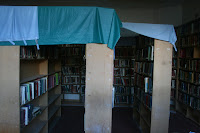Just before the trip ended, the train would snake past the gaol. From the train, I could never properly place the gaol's location. I didn't know much about the western side of the city, and so there were no landmarks I understood. I looked at it in much the same way I had looked, as a child, at the Goodwood Road Orphanage. Looking for wan faces to appear above walls or from windows, or for a message in a bottle to be flung from those same walls or windows, or to see some Fagin-like creature hiding in the trees.
Too much post-war children's literature.
Given that the gaol closed in 1988, and I only moved to Adelaide in 1987, I can't have trained past it too many times. Maybe it was only once. But in twenty years, I haven't forgotten the short-film feeling as the train moved slowly past.
Driving to the gaol during the past school holidays, I understand that the gaol is part of our famous, endlessly-discussed parklands, so follow my nose to the end of West Terrace, turn left down towards Port Road then miss the turn off. Too busy marvelling at the other weird sites. The traffic school. The police horse paddocks. So round the block and here we are. My boys and me.
I have read that the average age of prisoners ranged from 18 to 22 years.
My boys - aged seven and five - are excited to be here. They play endless games of 'under-arrests' and 'locked in jail'. That's why I've brought them here. To try and show them some of the complexities.

Built in 1841. Through that white door is the Sally Port which is a beautiful word for main entrance. These days, you go in through a door that's just to the left of the Sally Port.
I doubt my mothering instincts as soon as we're inside. You enter this gaol one group at a time, so we must wait until the family in front of us finishes at the first listening post. While we wait, my boys stand on their toes and crane their necks to look in the displays. Displays which show weapons fashioned from toothbrushes, forks and combs.
After we've walked through the visiting room,

we go into the doctor's surgery and my children hold my hands and my eldest boy says 'let's go out of here...this is freaking me out'.

They see it all through children's eyes of course and at the canteen say 'there's not many healthy choices there'

and at the telephone 'really, is that really a phone, how does it work'.
 Here's the library
Here's the library

 and a room that looks like the rooms we had at my school:
and a room that looks like the rooms we had at my school:
There's things that I don't tell my children or let them see. Like the room filled with grafitti and pasted with warnings about explicit material. I tell them 'it's not suitable for children. My youngest boy says 'why can't we look, why can't we' but my oldest boy says 'don't tell me anymore about that room'.
We walk past the tower where people were hanged and I (somehow) stop them from reading the sign. Gallows. That's right, they're called gallows.
I do point out the places where these people were buried, their places marked with their initials and date of execution. I want my boys to stop running and skipping. It doesn't feel right.

Honeycomb bricks make a noise as they collapse. It's a much more poetic solution than barbed wire.

There might be other trees visible from inside here, but these are the only trees I saw.








